 Backend Development
Backend Development
 PHP Tutorial
PHP Tutorial
 PHP basics Installing Apache Mysql PHP in windows environment (picture)
PHP basics Installing Apache Mysql PHP in windows environment (picture)
PHP basics Installing Apache Mysql PHP in windows environment (picture)
PHPRunning environment: Three installation methods under
Linux: source code package installation, rpm package installation, integrated environment installation (lnmp)
Two ways to install windows: single download installation, integrated environment installation (AppServ, phpstudy, wamp)
Install PHP development environment on Windows system:
The required software is installed independently:
Preparation before installation
Install Apache
Installation MySQL
Install PHP
Install phpMyA
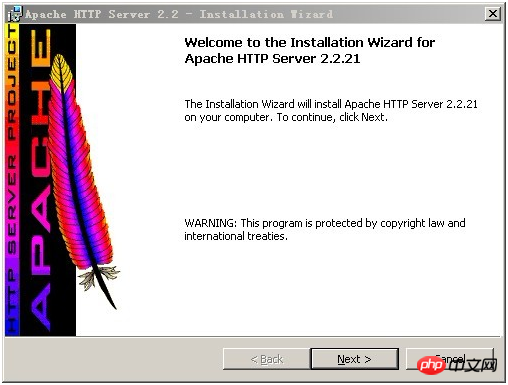
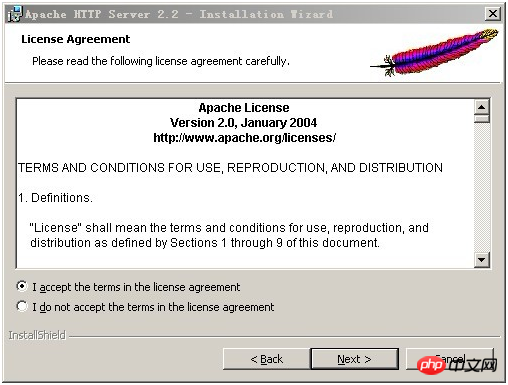
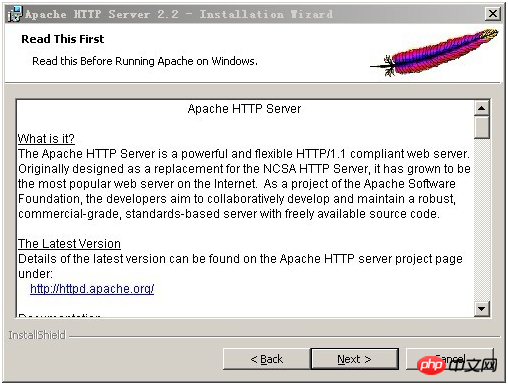

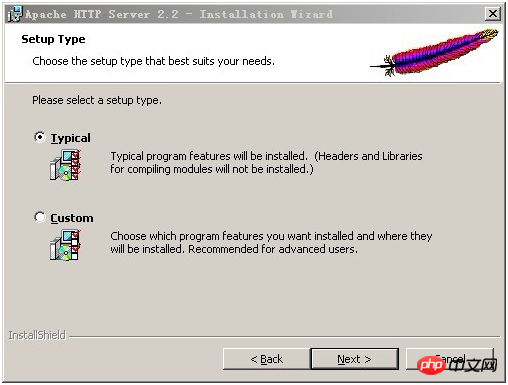
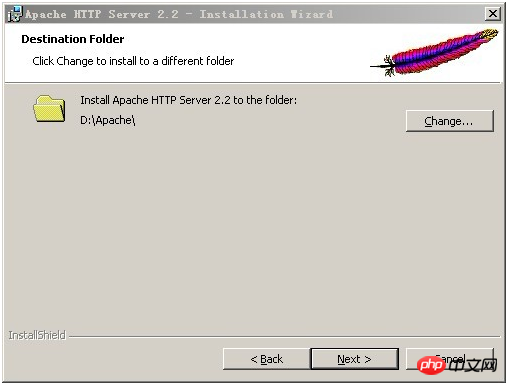

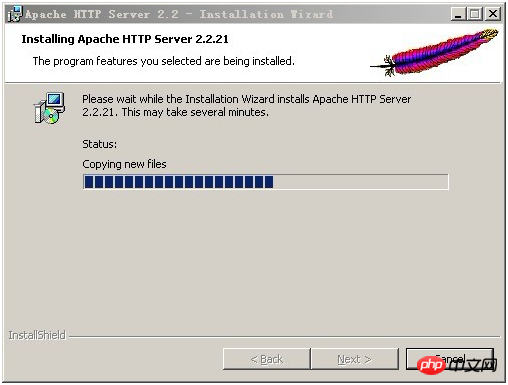


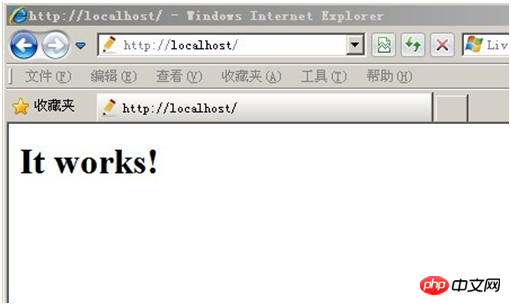
MYSQL installation:
Open the downloaded mysql installation file mysql-5.0.27-win32.zip, double-click to decompress it, Run "setup.exe", and the following interface will appear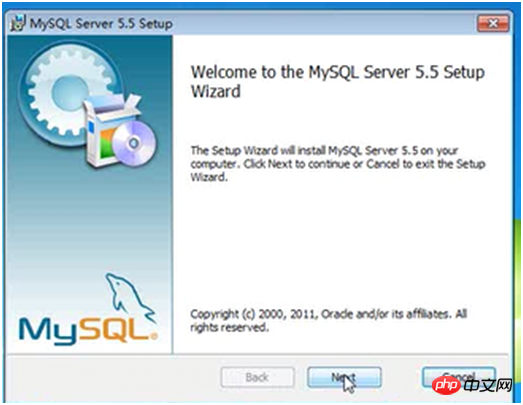
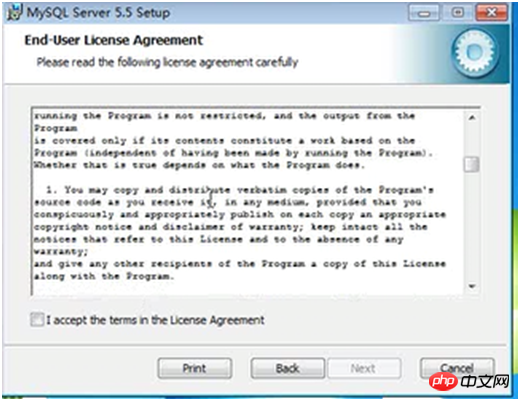
Select "I accept the terms in the license agreement" to agree to the license agreement, and then click "Next" to continue. In the window for selecting the installation type, there are "typical (default)", "Complete (complete)", " Custom (user-defined)" three options, we choose "Custom", because customization can make us more familiar with its installation process, which is very helpful for learning MySQL database. Click "next" to continue the installation, such as As shown in the picture:
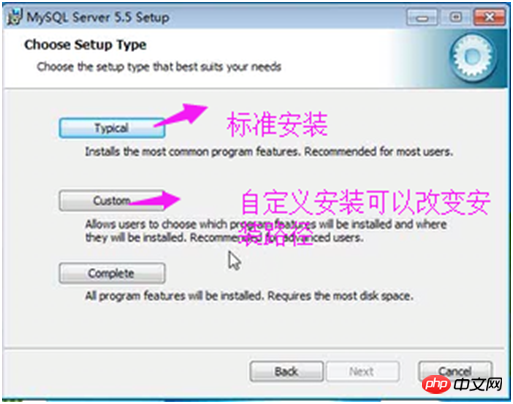
Select the installation path of the mysql database in the custom installation interface. Here I set "d:\Program File\MySQL", click "Next" to continue the installation, as shown in the picture:
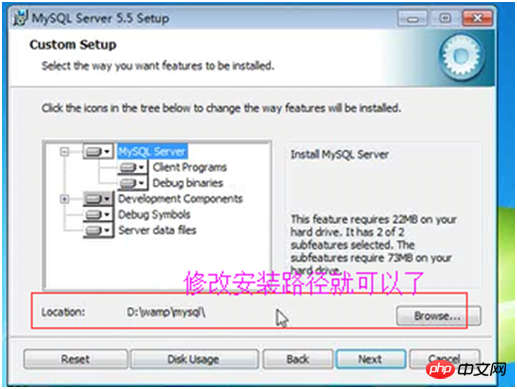
Next enter the interface to prepare for installation. First confirm the previous settings. If there is an error, press "back" Return, there is no error, click the "Install" button to continue the installation, as shown in the figure:
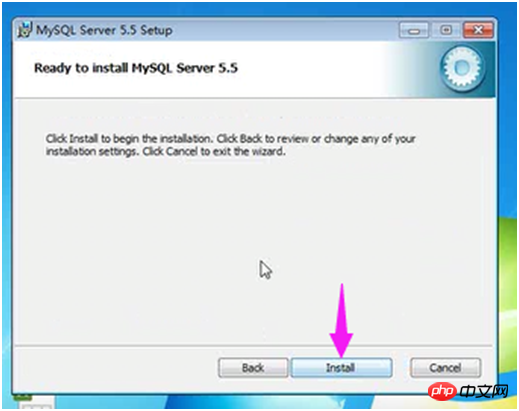
After clicking the "Install" button, the following installation interface appears. After a long time In a short time, the MySQL database installation is completed, and the interface to complete the MySQL installation appears, as shown in the figure:
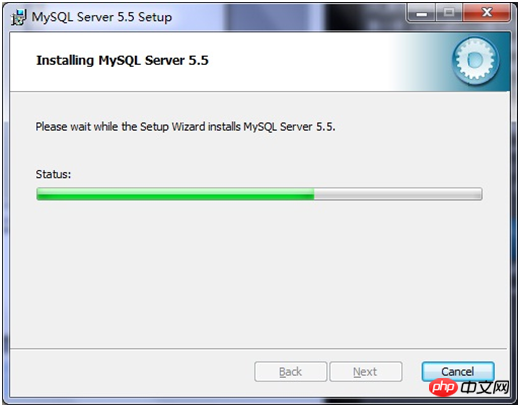
Just click "next" on this interface.
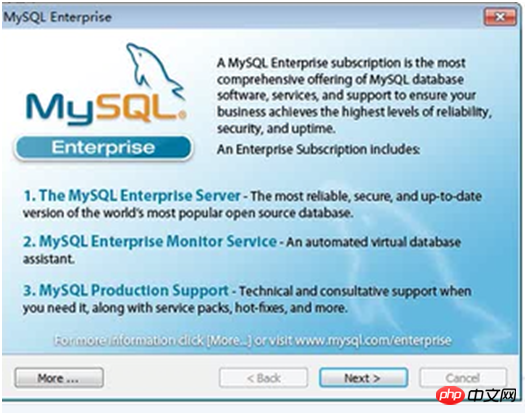
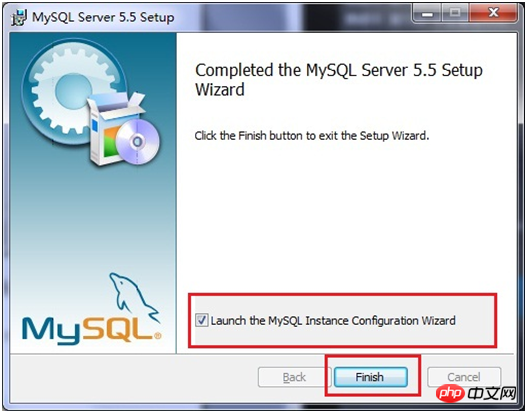
Be sure to select the "Launch the MySQL Instance Configuration Wizard" option above. This is the configuration to start MySQL and is also the most critical. (can also be set later), click the "Finish" button to enter the configuration interface.
The installation of MySQL database is very simple. The key is the configuration after the installation is completed. After clicking Finish, the following configuration interface wizard will appear. Click "next" to configure, as shown in the figure:

#Select the configuration method in the opened configuration type window, "Detailed Configuration (manual precise configuration)", "Standard Configuration (standard configuration)", in order to familiarize yourself with the process, we select "Detailed Configuration (Manual precise configuration)", click "next" to continue, as shown in the figure:
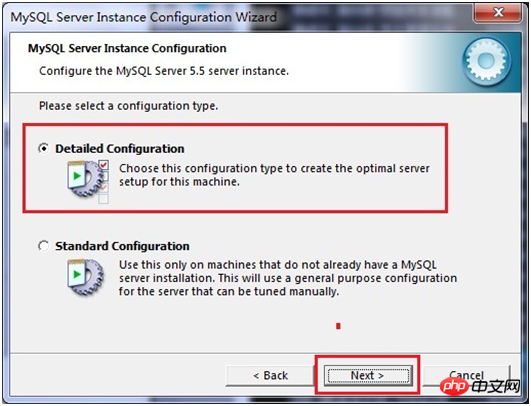
In the window that appears, select the type of server, "Developer Machine Test Class)", "Server Machine (Server Type)", "Dedicated MySQL Server Machine (Specialized Database Server)", we are only used for learning and testing, the default is fine, click "next" to continue, as shown in the figure :
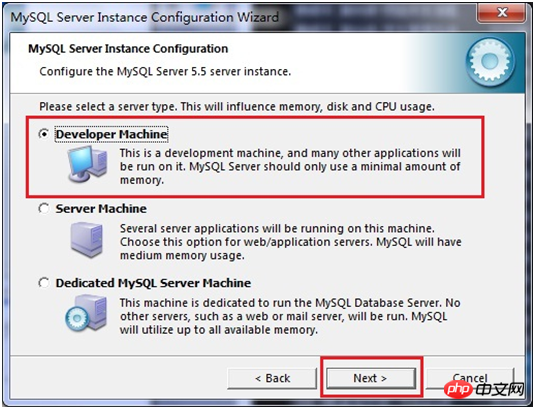
Select the purpose of the mysql database in the configuration interface that appears, "Multifunctional Database (universal multi-functional)", "Transactional Database Only (server type)", " Non-Transactional Database Only (non-transaction processing type)", here I choose the first item, universal installation, click "next" to continue the configuration, as shown in the figure:
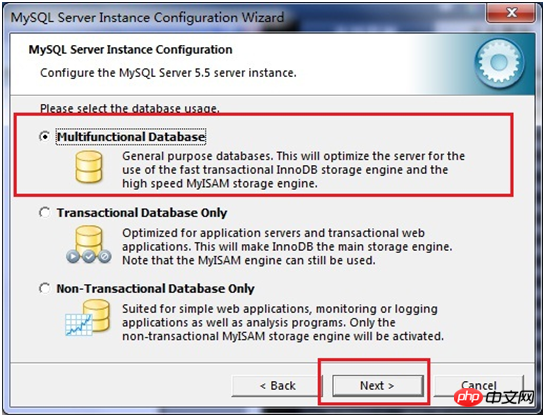
In the interface that appears, configure the InnoDB Tablespace, which is to select a storage space for the InnoDB database file. If it is modified, remember the location. Select the same place when reinstalling, otherwise the database may be damaged. Damage, of course, it will be no problem to make a backup of the database, as shown in the figure:
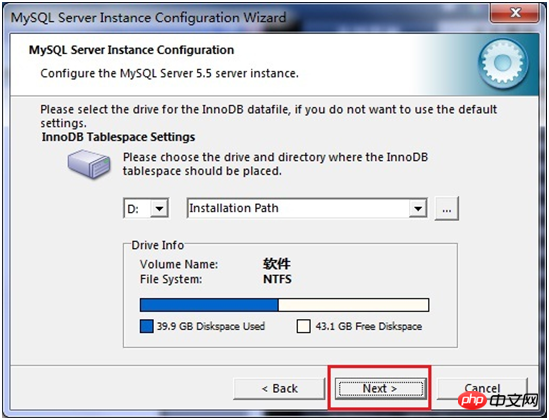
In the page that opens, select the number of mysql visits and the number of simultaneous connections , "Decision Support (DSS)/OLAP (about 20)", "Online Transaction Processing (OLTP) (about 500)", "Manual Setting (manual setting, set to 15)" Select manual setting here, click " next" to continue, as shown in the figure:

Mysql starts the TCP/IP network by default, and the port number is 3306. If you do not want to use this port number, you can also change it through the drop-down list box, but you must ensure that the port number is not occupied. The Add filewall exception for this Port checkbox is used to register this port number on the firewall. Select this option here. The Enable Strict Mode checkbox is used to enable MYSQL standard mode, so that MYSQL will strictly check the input data. , minor grammatical errors are not allowed. It is not recommended for beginners to select this item to avoid trouble. I have checked it here. You can not select this option and click "next" to continue, as shown in the picture. Display:
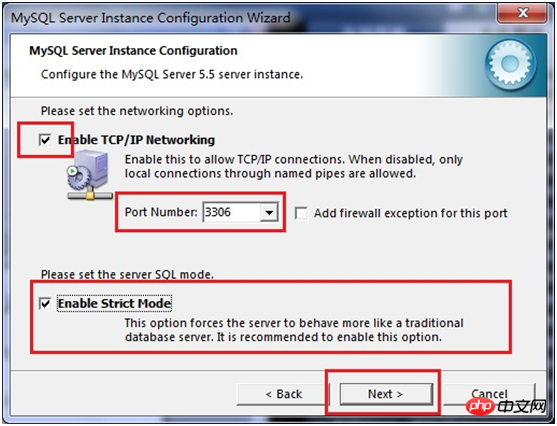
In the character encoding page that opens, set the character encoding to be used by mysql. The first one is Western encoding, and the second one is multi-byte. Universal utf8 encoding, the third one is manual, we choose utf-8. If the encoding of UTF-8 is not selected here, garbled characters will appear when using JDBC to connect to the database. At that time, you need to add the following The code "useUnicode=true&characterEncoding=UTF-8" can solve the problem of garbled characters. For future convenience, it is set to UTF-8 encoding, but there is a problem, that is, when using which console to insert Chinese characters, an error will be reported. Query Tables with Chinese characters cannot display Chinese characters. Therefore, you need to set a system parameter "set names gbk" every time you enter MySQL to solve this problem. Then click "next" to continue the configuration, as shown in the figure. :
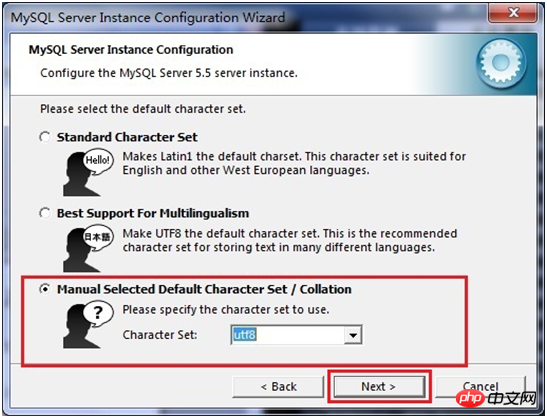
In the page that opens, choose whether to install mysql as a windows service, you can also specify the Service Name (service identification name), and whether to add the bin directory of mysql to Windows PATH (after adding it, you can directly use the files under bin without pointing out the directory name, such as connecting, "mysql –u username –p password;"), click "next" to continue the configuration, as shown in the figure:
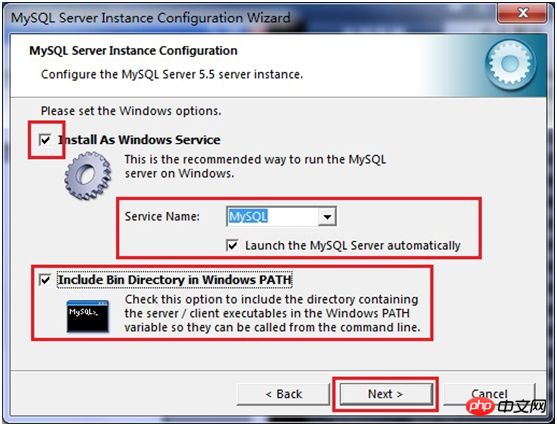
In the page that opens, set whether you want to modify the password of the default root user (super administrator) (the default is empty), "New root password", if you want to modify it, Just fill in the new password here and enable the root remote access function. Do not create an anonymous user. Click "next" to continue the configuration, as shown in the figure:
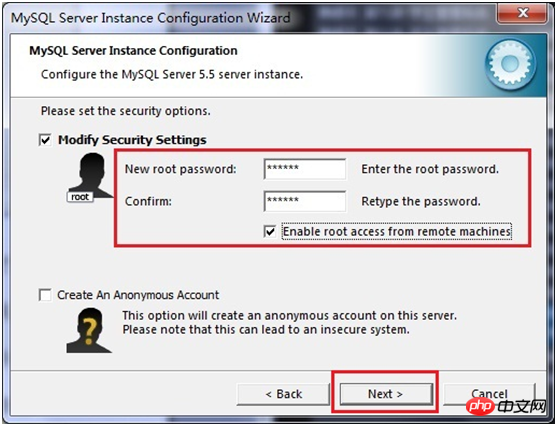
To All configuration operations here have been completed. Click the Execute button to execute the configuration, as shown in the figure:
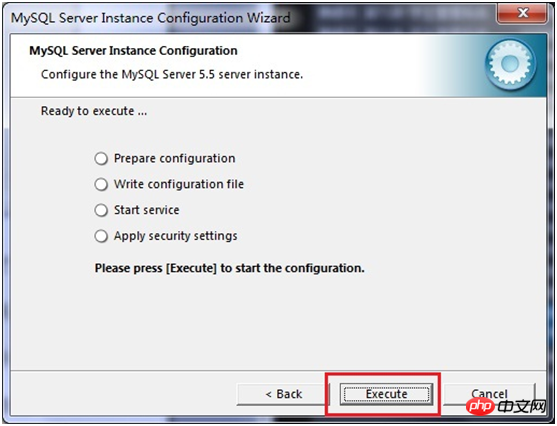
After a few minutes, the following prompt interface appears, which represents the MySQL configuration It has ended, and a successful message was prompted
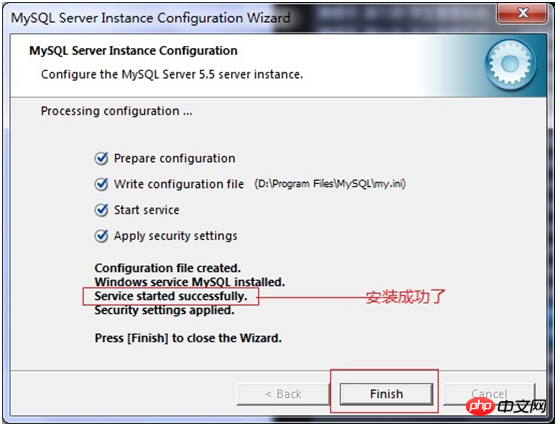 Start the mysql database in the service, and enter "mysql –h localhost –u root -p in the command window. ” or “mysql -h localhost -uroot -p password”, then enter the user’s password in the prompt that appears, as shown in the figure:
Start the mysql database in the service, and enter "mysql –h localhost –u root -p in the command window. ” or “mysql -h localhost -uroot -p password”, then enter the user’s password in the prompt that appears, as shown in the figure:
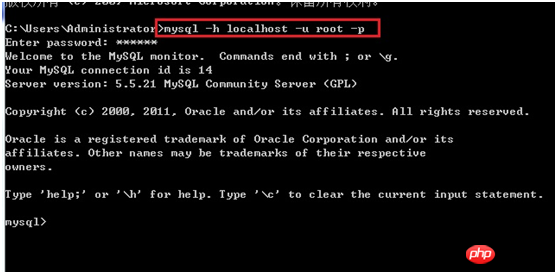 PHP environment installation:
PHP environment installation:
A. Install Apache
B. Install PHP (just unzip the compressed package to the corresponding location)
C. PHP configuration
Rename php.ini-dist to php.ini Modify 486 and
extension_dir = "D:/php-5.2.6/ext"
D, configure the Apache configuration file httpd.conf
#Load PHP module
LoadModule php5_module "D:/php-5.2.6/php5apache2_2.dll"
#The location of the PHP configuration file
PHPIniDir "D:/php-5.2.6"
#Which types of files will be processed by the PHP engine
AddType application/x-httpd-php .php
E , Restart Apache
Modify the httpd.conf configuration file
a) Modify line 177 to reset the document root directory
DocumentRoot "D:/ftp /Public/www"
b) Modify line 244 to set the website directory and document root directory to be consistent
c) Modify line 187 to set the website root directory access permissions
Allow from all
##d) Modify line 240 to set the website default document (if the set html document does not exist, it will List all files in the root directory of the website) DirectoryIndex abc.htmle) Restart apache service
PHP configuration
LoadModule php5_module "D:\Program Files (x86)\Apache Software Foundation\php5.2.6\php5apache2_2.dll"
PHPIniDir "D:\Program Files (x86)\Apache Software Foundation\php5.2.6"
AddType application/x-httpd-php .php
This way It's installed, it's quite simple, but there are a lot of steps.
The above is the detailed content of PHP basics Installing Apache Mysql PHP in windows environment (picture). For more information, please follow other related articles on the PHP Chinese website!

Hot AI Tools

Undresser.AI Undress
AI-powered app for creating realistic nude photos

AI Clothes Remover
Online AI tool for removing clothes from photos.

Undress AI Tool
Undress images for free

Clothoff.io
AI clothes remover

AI Hentai Generator
Generate AI Hentai for free.

Hot Article

Hot Tools

Notepad++7.3.1
Easy-to-use and free code editor

SublimeText3 Chinese version
Chinese version, very easy to use

Zend Studio 13.0.1
Powerful PHP integrated development environment

Dreamweaver CS6
Visual web development tools

SublimeText3 Mac version
God-level code editing software (SublimeText3)

Hot Topics
 Pi Node Teaching: What is a Pi Node? How to install and set up Pi Node?
Mar 05, 2025 pm 05:57 PM
Pi Node Teaching: What is a Pi Node? How to install and set up Pi Node?
Mar 05, 2025 pm 05:57 PM
Detailed explanation and installation guide for PiNetwork nodes This article will introduce the PiNetwork ecosystem in detail - Pi nodes, a key role in the PiNetwork ecosystem, and provide complete steps for installation and configuration. After the launch of the PiNetwork blockchain test network, Pi nodes have become an important part of many pioneers actively participating in the testing, preparing for the upcoming main network release. If you don’t know PiNetwork yet, please refer to what is Picoin? What is the price for listing? Pi usage, mining and security analysis. What is PiNetwork? The PiNetwork project started in 2019 and owns its exclusive cryptocurrency Pi Coin. The project aims to create a one that everyone can participate
 The latest version download of gate.io
Mar 05, 2025 pm 07:51 PM
The latest version download of gate.io
Mar 05, 2025 pm 07:51 PM
Need to download the Gate.io app to start your cryptocurrency journey? This guide details the latest version download steps for iOS, Android, and Windows devices. Simply visit the official website, find the download link and select the appropriate option based on your device. For iOS, it will go directly to the App Store, while Android and Windows users will download the APK or installer for manual installation. Once installed, you can launch the app and set up your account to step into the world of cryptocurrency.
 How to solve the problem of third-party interface returning 403 in Node.js environment?
Mar 31, 2025 pm 11:27 PM
How to solve the problem of third-party interface returning 403 in Node.js environment?
Mar 31, 2025 pm 11:27 PM
Solve the problem of third-party interface returning 403 in Node.js environment. When we use Node.js to call third-party interfaces, we sometimes encounter an error of 403 from the interface returning 403...
 What kind of disk-viewing software is used for Bitcoin
Mar 17, 2025 pm 04:27 PM
What kind of disk-viewing software is used for Bitcoin
Mar 17, 2025 pm 04:27 PM
Choosing the right Bitcoin market viewing software is crucial, it can help investors grasp market conditions in real time and make smarter investment decisions. This article will guide you how to make a choice, covering personal needs assessment (trading frequency, analysis depth, information needs and budget), software type selection (exchange interface, professional software, market website/APP), core functional considerations (data reliability, chart tools, custom settings, community communication and platform compatibility), and direction recommendations (maturity financial platform, cryptocurrency aggregation platform, community recommendation software). Finally, it is recommended that you try a few more software and compare it to choose the tool that best suits your needs. Please remember that software is only an auxiliary tool, and you must be cautious when investing at your own risk.
 How to download okx trading platform
Mar 26, 2025 pm 05:18 PM
How to download okx trading platform
Mar 26, 2025 pm 05:18 PM
The OKX trading platform can be downloaded through mobile devices (Android and iOS) and computers (Windows and macOS). 1. Android users can download it from the official website or Google Play, and they need to pay attention to security settings. 2. iOS users can download it through the App Store or follow the official announcement to obtain other methods. 3. Computer users can download the client of the corresponding system from the official website. Always make sure to use official channels when downloading, and register, log in and security settings after installation.
 Free installation of safe and trusted bitget application download app
Mar 04, 2025 pm 10:27 PM
Free installation of safe and trusted bitget application download app
Mar 04, 2025 pm 10:27 PM
Welcome to download the Bitget application to provide safe and reliable digital asset trading services. With our advanced platform, you can easily manage your portfolio and enjoy a smooth and user-friendly trading experience. Bitget applications provide high liquidity and in-depth markets to ensure you get the best execution price. We are committed to creating a safe and transparent trading environment for our users and always prioritize the security of your funds.
 How to efficiently integrate Node.js or Python services under LAMP architecture?
Apr 01, 2025 pm 02:48 PM
How to efficiently integrate Node.js or Python services under LAMP architecture?
Apr 01, 2025 pm 02:48 PM
Many website developers face the problem of integrating Node.js or Python services under the LAMP architecture: the existing LAMP (Linux Apache MySQL PHP) architecture website needs...
 Alibaba releases and opens the Tongyi Qianwen QwQ-32B inference model, with performance comparable to DeepSeek-R1
Mar 12, 2025 pm 01:00 PM
Alibaba releases and opens the Tongyi Qianwen QwQ-32B inference model, with performance comparable to DeepSeek-R1
Mar 12, 2025 pm 01:00 PM
Alibaba Cloud’s new open source inference model Tongyi Qianwen QwQ-32B, with performance comparable to DeepSeek-R1! On March 6, Alibaba Cloud officially announced the open source of its latest research and development inference model- Tongyi Qianwen QwQ-32B. The model has achieved significant improvements in math, code and general capabilities, with performance levels comparable to the industry-leading DeepSeek-R1 model. This news stimulated Alibaba's stock price to rise sharply, once rising by more than 8%. Alibaba Cloud confirmed in several authoritative benchmark tests that Qianwen QwQ-32B's performance far exceeds OpenAI-o1-mini and is on par with DeepSeek-R1 in overall performance. What's more remarkable is that the model has greatly reduced its performance while maintaining high performance.





